Viewing: Blog Posts Tagged with: alaska, Most Recent at Top [Help]
Results 1 - 25 of 34
Blog: E is for Erik (Login to Add to MyJacketFlap)
JacketFlap tags: Alaska, Texas, school visits, Iditarod, Add a tag
Blog: the enchanted easel (Login to Add to MyJacketFlap)
JacketFlap tags: winter, children's art, alaska, bird, holiday, etsy, sale, kawaii, december, penguin, acrylics, whimsical, original painting, the enchanted easel, arctic animal, december discount days, Add a tag
Blog: Miss Marple's Musings (Login to Add to MyJacketFlap)
JacketFlap tags: Alaska, survival, Native American Heritage Month, Indians, forbidden language, Debby Dahl Edwardson, My Name is Not Easy, Whites, 2015 Diversity Reading Challenge, Alaska Natives, being an outsider, Catholic boarding schools, Add a tag
I have chosen to Review My Name Is Not Easy as part of the celebration of Native American Heritage during the month of November. Title: My Name is Not Easy Author: Debby Dahl Edwardson Publisher: Marshall Cavendish, 2011 Themes: Alaska, Alaska Natives, Indians, Whites, … Continue reading
Add a CommentBlog: the enchanted easel (Login to Add to MyJacketFlap)
JacketFlap tags: penguins, winter, birds, snow, art, paintings, acrylic, alaska, kawaii, canvas, whimsical, arctic, aspen, the enchanted easel, fine art america, nuvango, vango art, Add a tag
Blog: the enchanted easel (Login to Add to MyJacketFlap)
JacketFlap tags: birds, children's art, kawaii, throw pillows, whimsical, alaska, winter, the enchanted easel, art, aspen, fine art america, penguins, arctic animals, Add a tag
Blog: OUPblog (Login to Add to MyJacketFlap)
JacketFlap tags: History, wolf, Journals, science, alaska, America, endangered species, wolves, extinction, endangered animals, Editor's Picks, *Featured, oxford journals, Science & Medicine, journal of heredity, Earth & Life Sciences, Matt Cronin, North American wolf, Add a tag
Wolves in the panhandle of southeast Alaska are currently being considered as an endangered species by the US Fish and Wildlife Service in response to a petition by environmental groups. These groups are proposing that the Alexander Archipelago wolf (Canis lupus ligoni) subspecies that inhabits the entire region and a distinct population segment of wolves on Prince of Wales Island are threatened or endangered with extinction.
Whether or not these wolves are endangered with extinction was beyond the scope of our study. However our research quantified the genetic variation of these wolves in southeast Alaska which can contribute to assessing their status as a subspecies.
Because the US Endangered Species Act (ESA) defines species as “species, subspecies, and distinct population segments”, these categories are all considered “species” for the ESA. Although this definition is not consistent with the scientific definition of species it has become the legal definition of species for the ESA.
Therefore we have two questions to consider:
- Are the wolves in southeast Alaska a subspecies?
- Are the wolves on Prince of Wales Island a distinct population segment?
The literature on subspecies and distinct population segment designation is vast, but it is important to understand that subspecies is a taxonomic category, and basically refers to a group of populations that share an independent evolutionary history.
Taxonomy is the science of biological classification and is based on evolutionary history and common ancestry (called phylogeny). Species, subspecies, and higher-level groups (e.g, a genus such as Canis) are classified based on common ancestry. For example, wolves and foxes share common ancestry and are classified in the same family (Canidae), while bobcats and lions are classified in a different family (Felidae) because they share a common ancestry that is different from foxes and wolves.

Subspecies designations are often subjective because of uncertainty about the relationships among populations of the same species. This leads many scientists to reject or ignore the subspecies category, but because the ESA is the most powerful environmental law in the United States the analysis of subspecies is of great practical importance.
Our results and other research showed that the wolves in Southeast Alaska differed in allele frequencies compared to wolves in other regions. Allele frequencies reflect the distribution of genetic variation within and among populations. However, the wolves in southeast Alaska do not comprise a homogeneous population, and there is as much genetic variation among the Game Management Units (GMU) in southeast Alaska as there is between southeast Alaska and other areas.
Our research data showed that the wolves in southeast Alaska are not a homogeneous group, but consist of multiple populations with different histories of colonization, isolation, and interbreeding. The genetic data also showed that the wolves on Prince of Wales Island are not particularly differentiated compared to the overall differentiation in Southeast Alaska and do not support designation as a distinct population segment.
The overall pattern for wolves in southeast Alaska is not one of long term isolation and evolutionary independence and does not support a subspecies designation. Other authors, including biologists with the US Fish and Wildlife Service, also do not designate wolves in southeast Alaska as a subspecies and there is general recognition that North America wolf subspecies designations have been arbitrary and are not supported by genetic data.
There is growing recognition in the scientific community of unwarranted taxonomic inflation of wildlife species and subspecies designations to achieve conservation goals. Because the very nature of subspecies is vague, wildlife management and conservation should focus on populations, including wolf populations. This allows all of the same management actions as proposed for subspecies, but with increased scientific rigor.
Headline image credit: Alaskan wolf, by Douglas Brown. CC-BY-NC-SA-2.0 via Flickr.
The post Are wolves endangered with extinction in Alaska? appeared first on OUPblog.
Blog: Write From Karen (Login to Add to MyJacketFlap)
JacketFlap tags: Photos, canada, alaska, vancouver, cruise, pier, Remember When ..., Add a tag
Kevin took this picture while we were waiting to board our cruise ship in Vancouver, Canada in October 2013. We were cruising to Alaska. And though I had to talk Kevin into this cruise it actually ended up being the best cruise we’ve been on so far. (And judging by my flushed cheeks, I was having a hot flash).
Filed under: Photos, Remember When ...
Blog: Beth Kephart Books (Login to Add to MyJacketFlap)
JacketFlap tags: Alaska, The New Yorker, National Endowment for the Arts, Dan Chiasson, Olena Kalytiak Davis, and Other Poems, The Poem She Didn't Write, Add a tag
I'm absolutely certain that Olena Kalytiak Davis would not have loved the idea of me sometimes looking for the ephemera of her when I visited Alaska this past summer.
But I did. I searched. Couldn't help it.
I'd met her at Bread Loaf. She'd haunted us all. Reading in the moted light about a wedding dress. Sitting on a stoop in the early morning, the smoke of a cigarette swirling. The things people say and the things she said, and the delicate and fierce in her, and later, riding a train from DC with a fellow National Endowment for the Arts juror, the talk between him and me was almost all Olena. Where she was. What she was doing. How much better mystery is, than fame.
She lives in Alaska. She's a single mom and an attorney. She has a new book out, a third, "The Poem She Didn't Write and Other Poems." And also: Dan Chiasson just gave her two amazing pages in this week's issue of The New Yorker.
I gasped when I saw it. Hadn't find her in Alaska. Found her here, in the dark, after a many-hour work day, when I needed a little actual poetry.
From the last paragraph in this exquisite bit of appreciation, lessons on poetry, thoughts on Davis:
The medium of poetry isn't language, really; it's human loneliness, a loneliness that poets, having received it themselves from earlier poets, transfer to their readers. Like bees in a honeycomb, writers and readers experience isolation and solitude communally and collaboratively.... Writing a poem, you create that vivid otherness; reading one, you re-create it in your own person. These two lonely souls, writer and reader, are bound to one another. They can be miles or centuries apart, but in Davis's book the passage between them sees some heavy traffic.
Blog: the enchanted easel (Login to Add to MyJacketFlap)
JacketFlap tags: the enchanted easel, winter, art, sketch, children's art, pencil, alaska, bird, wip, kawaii, penguin, whimsical, arctic, Add a tag
Blog: Beth Kephart Books (Login to Add to MyJacketFlap)
JacketFlap tags: Alaska, National Geographic Alaska Cruise, Add a tag
Yesterday, this:
A client sends a gift of blank notebooks in the wake of a job I gladly did (so many jobs, through so many years, I've done—but this gift, so unexpected). An author for whom I read and blurbed a debut novel sends a beautiful card and gift—wholly lovely thoughtfulness. The weather unfolded, magnificently. I wrote the first two pages of a book.
All of that was enough and then, end of day, an email from the impeccable Elly P. of Alaska-trip fame arrives. The world's top National Geo Junior Explorer who has a travel pedigree that outshines most, wears a camera around her neck like a pro, jumps into frigid bay water with nary a blink, and kept me company on a glorious boat with stories about herself and at least one fantastical story that she made up on the spot, while spreading Nutella across her breakfast toast.
Elly P. Elly P. All these weeks later, she writes to me.
Elly, you may have taken a bunch of photos of the crazy author lady with the untamed Alaska hair, but I've got pictures of you being your glorious intelligent, determined, clever, funny self. I've got these.
Magical camera. I'm in.
Blog: Blog of the Cold Snap Illustrator (Login to Add to MyJacketFlap)
JacketFlap tags: Alaska, North Pole, bookmarks, Add a tag
 |
| North Pole, Alaska Old English Sheepdog Santa Handmade Bookmark |
 |
| North Pole, Alaska Christmas Town Santa Claus Handmade Bookmark |
Have you ever been to North Pole? It's this adorable little Christmas-themed town in interior Alaska (not far from Cold Snap Studio)!
These new North Pole, Alaska Santa bookmarks with state charms make unique Alaskan souvenirs and awesome Christmas gifts, whether you've been to North Pole or not! Check them and other cool bookmarks out on our website!
______________________________
As a reminder, you can view our sales and DAILY DEAL and reach our site through these other websites as well:
WashYourHandsSigns.com, PremieSigns.com, CHDSigns.com and CarSeatSigns.com!
Blog: Beth Kephart Books (Login to Add to MyJacketFlap)
JacketFlap tags: Renegade Science, Alaska, Humpback whales, James Nestor, National Geographic Alaska Cruise, and What the Ocean Tells Us About Ourselves, Deep: Freediving, Add a tag
I carried James Nestor's DEEP to Alaska so that I might learn more about the seas. The oceans that gave birth to us, the darkness where strange life hovers, the gigantic brain of the elusive sperm whale, the unbelievable feats of divers who compete against themselves and their own bodies to dive thirty stories or more on a single lungful of air. (They dive; they must return; they cannot breathe until they do; they bleed; they lose consciousness; they dive again.)
I had been drawn to the book by the New York Times review. I found myself wavering as I read. Intrigued by the content and by our mighty oceans. Feeling boxed in or boxed out by the format. Nestor is a journalist. His book is a first-person exploration organized around sea-level depths. What is discovered 60 feet down, 300 feet, 650 feet, 800 feet down, say. The researchers who are trying to understand. The divers addicted to compression.
There's much to be gained, imagined, felt from a book like this. And Nestor certainly has done his research, is sincere in his desire to meld with his subject matter, is enthusiastically participative. But by organizing this discussion of the ocean around Nestor's own experiences, by writing, mostly, in a clipped present tense, Nestor at times delivers fragments where they might be wholes, more about himself than we might, in this case, need, details that seem out of place.
The book, for example, begins like this:
I'm a guest here, a journalist covering a sporting event that few people have heard of: the world freediving championship. I'm sitting at a cramped desk in a seaside hotel room that overlooks a boardwalk in the resort town of Kalamata, Greece. The hotel is old and shows it in the cobweb cracks along the walls, threadbare carpet, and dirt shadows of framed pictures that once hung in dim hallways.Later, this:
It takes fifteen hours, three meals, four small bottles of wine, seven films, and five trips to the bathroom to fly from San Francisco to Sydney, Australia. Next, there is a four-hour layover in Sydney International Airport (one bagel, a twenty-minute nap on the floor, one bag of cashews, forty-five minutes at the newsstand reading Rolling Stone) before the connecting flight to Saint-Denis, the capital of Reunion.....There is more of this sort of thing—a lot of it, in fact—woven in between the interesting histories of oceanic research and the images of the wily creatures of the deepest depths. As a reader interested in oceans, I learned. As a teacher of memoir who celebrates the first-person voice, I wondered, often, whether a book like this was a proper use of the first-person present. Would a different tense have allowed the ocean to take center stage? Would a close-over-the-shoulder third person have given Nestor more room to make this an even greater, more sweeping study of the seas?
So much, always, to ponder.
Blog: Beth Kephart Books (Login to Add to MyJacketFlap)
JacketFlap tags: Alaskan glacial ice, All the Light We Cannot See, Alaska, Michael Ondaatje, Colum McCann, Alyson Hagy, Anthony Doerr, Alice McDermott, Add a tag
In Alaska, a new friend asks me what I am reading and I say Anthony Doerr, All the Light We Cannot See. I show her the book's first page, and she says, "Read it to me. Out loud." I demur. She insists. I read. In the belly of the boat while the glacial mountains float by. "Leaflets," I say, reading the chapter title. Then:
At dusk they pour from the sky. They blow across the ramparts, turn cartwheels over rooftops, flutter into the ravines between houses. Entire streets swirl with them, flashing white against the cobbles. Urgent message to the inhabitants of this town, they say. Depart immediately to open country.I hear my own breath catch. I look up into Kristi's face. She isn't sure, quite, about the passage I've read, wants to know why it has enchanted me. I read phrases out loud again, verbs, that word incendiary webbed into the lush lyric of the cartwheels, the flutter. How can you speak about what you love? How can you convey the genius of Anthony Doerr, who has never been more genius than this new novel of his—541 pages long, ten years in the making, and it reads too fast, you could read it in a day, you cannot read it in a day, for there will be nothing like it again or soon. Doerr is like Ondaatje, Doerr is like McCann, Doerr is like McDermott, Doerr is like Hagy, Doerr is a writer, pure.
The tide climbs. The moon hangs small and yellow and gibbous. On the rooftops of beachfront hotels to the east, and in the gardens behind them, a half-dozen American artillery units drop incendiary rounds into the mouths of mortars.
And this new book—about a blind girl in France and a smart boy in Germany and the war that brings them together but only after terrible journeys and terrible losses and only for a moment—this new book is wrenching and glorious. Wrenching first. Glorious because of its deep and tender soul. Because Doerr embraces life even in the midst of dying. Because Doerr inclines toward science as he writes his art, which is to say that he inclines toward the curious mysteries of our world. Snails. A massive diamond. Electromagnetic waves. The cell that divides and divides again, until it is a human, howling.
I love this book. I believe in it, wholeheartedly. I believe in Doerr. Why do books still wear labels—YA or A, historical or contemporary, literary or not? Banish them. Now. Anyone who loved The Book Thief will be astonished and grateful for this book. Anyone who swoons over an Ondaatje sentence will recognize the power here. Anyone who wishes to return to France or Germany at the time of a devastating war will be returned in a fresh way, an eyes wide-open way.
Anyone who reads will emerge brokenhearted but also grateful that Doerr doesn't just break our hearts. In surprising and redeeming ways, he heals them, too.
Blog: From the land of Empyrean (Login to Add to MyJacketFlap)
JacketFlap tags: poaching, fur hat, historical fiction, Minnesota, Alaska, Charlie Chaplin, mining, swan, gold rush, Add a tag
Today's guest comes to us from the wilds of Alaska and back again. Katherine Holmes makes a stop on her blog tour with some background info on her novel The Swan Bonnet.
Learning about Alaska was like learning grammar through a foreign language. I've never read a history book about Minnesota though I have Midwestern ancestry going back to the mid-1800s. Mining hopes in Alaska were very similar to those on Minnesota's Iron Range in the early 20th century. The influx of people in Northern Minnesota had similarities to Alaska’s new population. Sometimes they were the same people. Like Alaska, the fur trade began Minnesota history. I'd heard much about the 1920s on the Iron Range from my mother. Boomtowns and sudden wealth mapped the region.
After being fascinated with two books of Alaskan history, I researched swans. I read how warehouses with thousands of swan pelts were discovered, more than 10,000 at a time. Eventually hunting laws were enforced and a successful environmental chronicle was documented. I began my Alaska story as a shorter fiction about an Irish immigrant couple who bought shore property where swans migrated. But soon the story led to a coastal town and characters emerged.
When I thought of the swans being killed in masses, I knew that few women were part of such a money-making venture. How much did women help such an environmental campaign in a lone setting when a particular species were illegal to hunt? It is known how women responded to Prohibition then.
Not until I was rewriting the book did I realize the inspiration for the swan hat. Of course, it was meant to be the white hat of the western. But I remembered from my grade school years the pheasant pelts one of my brothers brought home after hunting. He hung the pheasant pelts on the wall of his room and then in the basement. These pelts fit neatly on the head so that, with my friends, I wore a pheasant hat - until my mother found out and scared us about lice. There is some kind of method to storytelling after all.
Blog: How To Be A Children's Book Illustrator (Login to Add to MyJacketFlap)
JacketFlap tags: Pictures worth a thousand words, Sitka, Mark Mitchell, Swan Lake, carol, online course on children's book illustration, Children's book illustration, New Year, christmas, nature, home, Alaska, Add a tag
Stepping away from the news and business this evening, I poked around on YouTube for a nice Christmas video to share with you. For some reason I started wondering if Sitka, Alaska, where I’d spent 2-3 of my childhood years still celebrates Christmas. I remember a Christmas there that lit up the dark Alaskan winter. [...]![]()
Blog: blog 30 x 30 - Chuck Dillon's blog. (Login to Add to MyJacketFlap)
JacketFlap tags: Central Park, snow, polar bears, Alaska, city, Highlights for Children, Anchorage, High Five, Nome, that's silly, what's wrong?, Dog Sled Race, Add a tag
Blog: A Garden of Books (Login to Add to MyJacketFlap)
JacketFlap tags: Alaska, Robert J. Blake, Add a tag
As a Siberian Husky pup Togo was not thought to be a good sled dog by Leonard Seppala. Leonard thought him to be "too small, too independent and too wild for his team." Togo would become apart of an important team of dogs that were needed for more than just a race. A Diphtheria antitoxin was needed for an epidemic in Nome. Seppala and his team would need to work harder than they've ever worked, time was their enemy.
I loved this story!
This is the true story of a courageous and resilient dog named Togo.
I enjoy reading stories of areas of our world where I'm not as familiar with. In this way I view the world outside of my "little box" and understand other cultures, peoples, geography, and beliefs.
Togo is an inspiring read. An animal story of a dog that is intelligent, wise, and has the perseverance that some humans do not have.
I feel that children would love this story, it really spoke to my heart.
Published by Philomel Books in 2002, A Division of Penguin Putnam Books for Young Readers
48 pages
For ages 6-9
Link @ Barnes and Nobles:
http://www.barnesandnoble.com/w/togo-robert-j-blake/1005203794?ean=9780399233814&r=1&cm_mmc=AFFILIATES-_-Linkshare-_-GwEz7vxblVU-_-10%3a1&
Hardcover $13.42
Blog: Loni Edwards Illustration (Login to Add to MyJacketFlap)
JacketFlap tags: running, alaska, race, map, fourth of july, seward, they draw & travel, blog, Add a tag
The Fourth of July is a big event in a former hometown of mine, Seward Alaska. Every year, the little town of approx 3000 expands to approx. 30,000 to celebrate this holiday. The main reason for this is the annual running of one of America’s oldest footraces, The Mount Marathon Race®.
Runners from all over the world participate in the running up and down of the 3022 foot mountain. As a former racer, I can tell you that it is one of the most exhilarating things I have experienced in my life.
Here is a map I did of Seward for They Draw & Travel:
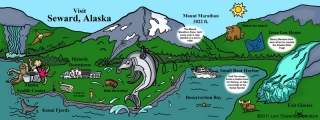
Good luck to my sister, brother-in-law, twin nieces, and friends as the race this year! Be safe and have a happy 4th!
*Note* for those that would like to view the race via livestream check out Ktuu.com’s site for full coverage of the race which starts at 930 am Alaska time, July 4th. To learn more about the Mount Marathon race, visit the Seward.com website.
Blog: Kid Lit Reviews (Login to Add to MyJacketFlap)
JacketFlap tags: 5stars, Library Donated Books, travel guides for kids, vacation planing, Children's Books, NonFiction, non-fiction, Seattle, Middle Grade, New York, Alaska, Add a tag
5 Stars All ALASKA: Cooper visits Alaska with the help of his new friend and guide, Kodi the Moose. Follow the two on their Ultimate Alaska Adventure as they explore Juneau, Skagway and Ketchikan. From the Mount Roberts Tramway and the Mendenhall Glacier in Juneau, to Skagway’s White Pass & Yukon Route Railroad, and finally [...]![]()
Blog: Loni Edwards Illustration (Login to Add to MyJacketFlap)
JacketFlap tags: blog, alaska, projects, map, Add a tag
My map of my former hometown of Seward, Alaska is now up at they They Draw & Travel. Go check it out here!
Add a CommentBlog: Galley Cat (Mediabistro) (Login to Add to MyJacketFlap)
JacketFlap tags: vice president, Sarah Palin, Mudflats, governor, Howard Books, exposé, Frank Bailey, Jeanne Devon, Joe McGinness, Ken Morris, leaked manuscript, Celebrities, Deals, president, Alaska, John McCain, Add a tag
 Former Sarah Palin aide Frank Bailey has landed a deal with Simon & Schuster’s Howard Books. His memoir, Blind Allegiance to Sarah Palin, will be released on May 24th.
Former Sarah Palin aide Frank Bailey has landed a deal with Simon & Schuster’s Howard Books. His memoir, Blind Allegiance to Sarah Palin, will be released on May 24th.
Bailey became close to former vice presidential candidate Sarah Palin during her gubernatorial campaign; he remained in her inner circle during John McCain‘s presidential race. He co-wrote the memoir along with author Ken Morris and Mudflats blogger Jeanne Devon. On her site, Devon revealed that the three writers spent two years on this project.
Bailey had this statement in the press release: “I write because I am convinced that Sarah’s priorities and personality are not only ill-suited to head a political party or occupy national office, but would lead to a disaster of, well, biblical proportions.”
New Career Opportunities Daily: The best jobs in media.
Add a CommentBlog: I.N.K.: Interesting Non fiction for Kids (Login to Add to MyJacketFlap)
JacketFlap tags: doodles, illustrations, animals, Native Americans, ocean, Alaska, whales, Arctic, Eskimo, Iñupiat, Add a tag
There’s been a lot of discussion about invented aspects of nonfiction lately, although of course it has always been an issue: whether to use only direct quotes in context, and not to envision conversations; whether to connect points A and C with a B that seems necessary but is unknown; whether -- and how -- to fill in the blanks of a narrative.
Although the answers are full of grey area (and controversy) they seem more black and white to me than do answers to similar questions about illustrations. While illustrators must use real, reliable references, they also make tricky decisions about what to show -- and wander the border between fact and fiction struggling to envision a scene that demonstrates the heart of the story being told or the situation being described.
Take my current work, for example. I’m writing this blog post in a break from my forthcoming graphic article, White Whale on the Go, a Humanimal Doodle (For more on these, please see my Humanimal post or the Humanimal section of my website. ) Here’s the story this doodle tells:
The tiny Iñupiat Eskimo village of Point Lay, Alaska depends for its food on beluga and bowhead whales that migrate through. The Iñupiat have dispensation to hunt a small number of whales for subsistence. Scientists trying to learn more about beluga behavior and physiology asked the Iñupiat for access to the whales -- specifically, they asked for help catching whales so they could be tagged with data transmitters that would track their paths, and for tissue and blood samples from recently killed whales. These samples were used to compare the wild beluga with belugas kept at Mystic Aquarium in Connecticut.
After several years of cooperative work, two Point Lay men were invited to visit Mystic to see the labs where the research was conducted and to visit the aquarium’s whales. Enthralled, they asked that other people from Point Lay be invited, and they were quite specific about whom: high schoolers. Not only did the men want the cooperative effort to continue -- because scientists are monitoring the effects on whales of climate change, expanded shipping lanes, and increased drilling for oil -- but they wanted the next generation to lock things in. Moreover, they hoped their young people might be inspired to go into science.
This year, four Point Lay girls visited Mystic, and I drove up to meet them and to talk to the scientists they were working with. I came home with good notes and great quotes, and now I had to turn them into a visual story. My Humanimal Doodles are all, uh, doodled, so photographs were out of the question. But I did have photographs showing the girls meeting Mystic’s three beluga whales, wearing chest-high waders to enter the chilly pool.
Blog: A Garden of Books (Login to Add to MyJacketFlap)
JacketFlap tags: Debby Dahl Edwardson, Arctic Circle, Alaska, Native American, Add a tag
Link for the book @ publisher:
http://us.macmillan.com/fsgyoungreaders.aspx
Age range 10 and up, 192 pages, Fiction, Young Adult,
The authors website:
http://www.debbydahledwardson.com/
The authors blog:
http://www.debbydahledwardson.com/blog.htm
This book was borrowed from the library for the purpose of reading/reviewing.
Blessing's Bead is a multi generational story of two young girls from different time periods that live in the Arctic Circle.
In the first story Nutaaq and her older sister Aaluk are traveling to a trade fair. The sisters are close, their bond is strong. The time period is the early 20th Century. They live in the Arctic Circle and they are Inupiaq--Eskimo Inuit Native Americans. A Siberian young man that is wearing blue beads has his eye on Aaluk. Nutaaq is watching their interest in one another. The trade fair is an event that they all look forward to, the ability to meet and socialize with others and trade their goods is necessary. Historical events will take place and life changes for these two sisters.
Many years later another young girl named Blessing is traveling with her brother to live with their great grandmother at the Arctic Circle. They had been living in Anchorage, but were taken away when their mother was no longer able to care for them. Life in the Arctic Circle is a challenge, yet there is a strong bond with their great grandmother. Blessing finds a blue bead and her great grandmother shares with her the story.
I loved this story! It was hard for me to put this book down, I finished reading this book in just a few hours.
The book gave me a perfect picture image in my mind of what life is like living in the Arctic Circle. The vivid imagery made it easy for me to feel the icy cold weather.
This is a people group and a part of the world that I knew little about and I am glad that I read this book.
I loved the blending of the two stories together, and the effect on the generations.
I loved the depth of love and selflessness shown in the families.
The writing is simple and easy to understand and read.
The book would be an excellent tool to use in the classroom.
Blissful Reading!
Annette
Blog: Teachers Are Sparklighters for Literacy Everyday! (Login to Add to MyJacketFlap)
JacketFlap tags: motivation, discussion, alaska, families, summer reading, engagement, teacher resources, Add a tag
Let's Keep Them "In the Pool"
We all know how important the summer months can be for students. With little stimulation or opportunity, they can lose more than 3 months' progress during the time they are away from school. Today's post will share resources and information on how you can use these last few weeks to impact summer learning.
I'll begin with a wonderful list of articles, websites, and research from the the State Library of Alaska. You will find familiar names like Dr. Richard Allington and Steve Kreshan and a few new ones there.
Here are a few more tools for supporting and encouraging students to read during the summer:
Connect with your local library and other organizations that may be promoting reading with school aged children in your community (booksellers like Amazon and Barnes and Nobles are on board). Find out what they are doing and publicize those activities and resources with students and families. My own local library, Huntsville/Madison County Public Library (AL), is offering an End of the Year Summer Reading Party!
Make reading a social event. Give your students a few extra minutes every day to talk about what they are reading. Use colorful, florescent index cards or post its and create a cool "What's HOT?" bulletin board.
Blog or text with your students about what you and they are reading (and viewing) this summer. You'll need parent permission, but even a core group can make a difference. I know that you want to be "away" for a while just like the students do but a small investment can yield big dividends. Set a few guidelines such as how often to post and encourage the online conversation to weave between story lines and characters and what your students are doing during their summer vacation. You might even see some text to self and text to world connections and squeeze in a bit of authentic writing practice!
Get Families Involved
Families may not understand what can be lost during the summer without reading and writing. Be sure you share with them a few bits of information and some encouraging resources. Check out Summer Reading to help moms and dads, grandparents, and caregivers tap into the joy, expl
Blog: Sarah McIntyre (Login to Add to MyJacketFlap)
JacketFlap tags: alaska, Add a tag
Okay, a lunch-time post. I really want to get all my Alaska pics up so later I can go back through them and remember the trip. I like this drawing of the house just the other side of the bridge on the slough. 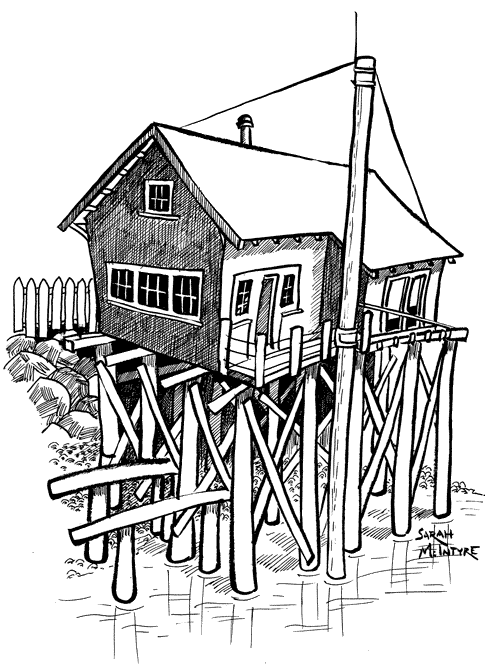
I sat on a rock to draw it and hoped the kids on the bridge above me who were snagging salmon wouldn't snag me by mistake. Here they are, hitching a ride to the airstrip. We saw a lot of them, although I don't think we ever learned their names.
Here's the harbour. There's a huge derelict ship docked there called the Husky II, and its hull is so thin that someone's foot can go right through it. If it sinks in the harbour, it'll cost a bomb to raise and remove. It's all stripped down and ready to take out to sea and sink to become a shellfish reef, but the politics of removing it are so complicated that it's been sitting there for several years, threatening to go down at any moment. Lovely rust patterns on it, though.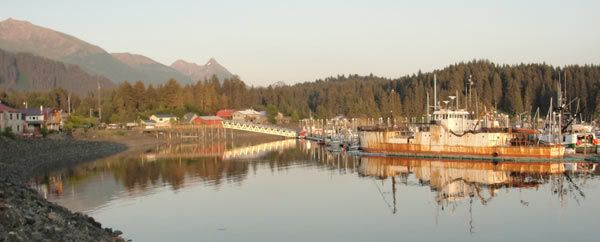


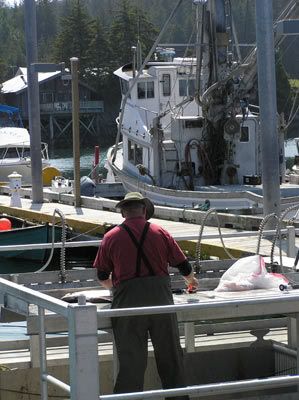
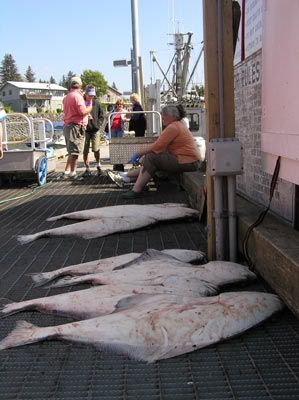

Halibut and a rock fish. It's better to catch the halibut when they're not so big (they can grow to over 400 pounds) because the larger fish are the breeders. That's because, while halibut start out male and female, they all turn female when they're older. Cool fact of the day. Well, it's what I was told, but they might have been teasing. 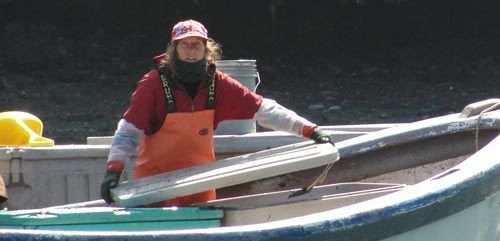

We went to a wake for my uncle's old fishing friend, Tuggle Int-Hout, who had also been a good friend of his father's. He died last autumn, but everyone was in town for the 4th of July. So the next-door neighbours invited Tuggle's wife, Esther, and the people who'd known them to a gathering where everyone told stories about Tuggle (a lot of them pretty raunchy). 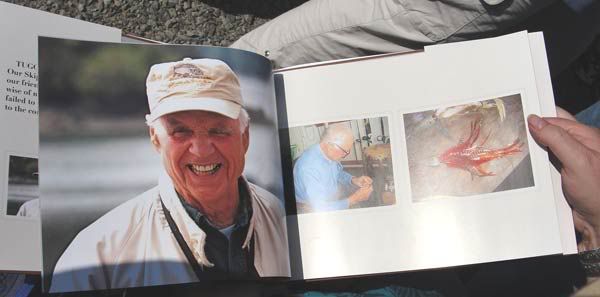
Tuggle had made a big impact on the community and was much missed. This is a book his brother made about him (using iPhoto). 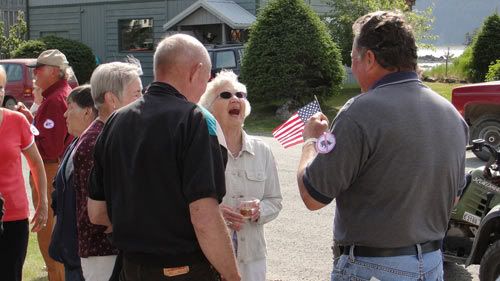
We went out deep-sea fishing with Tuggle last time we were in Seldovia because he knew how to navigate well and where all the fish were, but this time we didn't fish, just went otter-watching and stuff like that. That was great, but we were sorry we didn't get to go out with Tuggle again.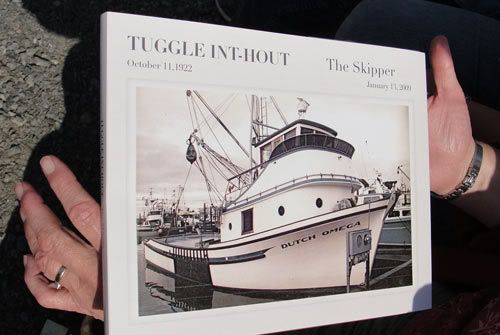
Here's the Harbor Master at the wake. She's a force to be reckoned with; I loved listening to her give the boat owners hell over her loudspeaker if they didn't dock where she wanted them to. And the guy is Kirby, who does construction work on the stilt houses and has the greatest Clint-Eastwood-esque features.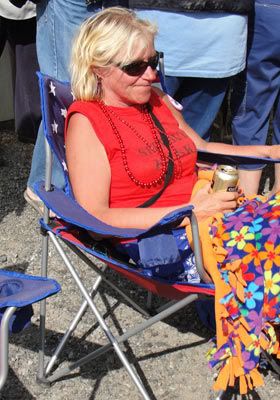
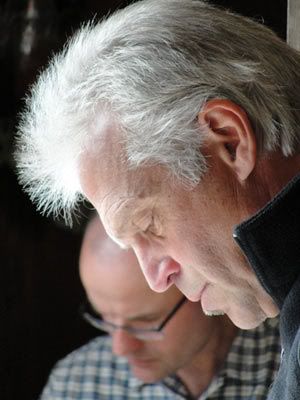
Here's my uncle baking oysters on the barbecue (we had some raw and some baked - both very tasty), and a couple more house shots, just because I like them. Fortunately the oysters and the outhouse were in no way linked.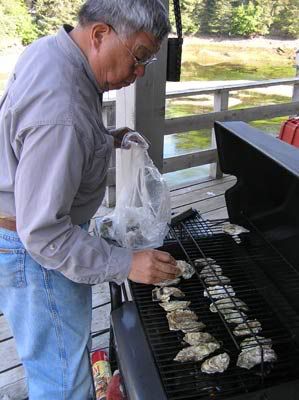
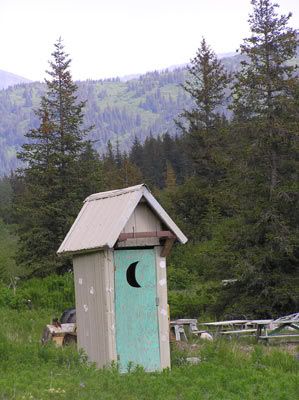 <
<
View Next 8 Posts









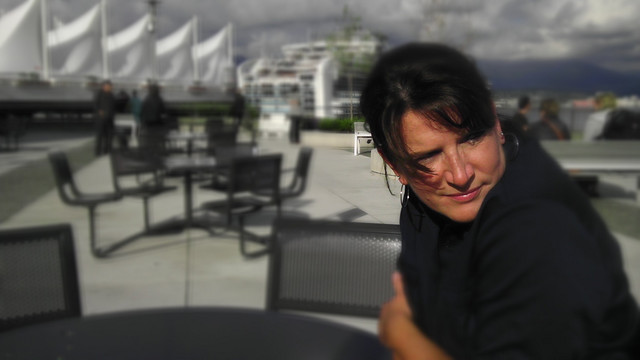



















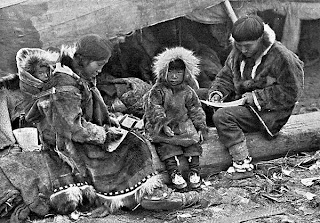


No doubt your site is amazing and I really like it. Nice writing, you are doing great effort, your way of writing is unique. Love this site.
urdu novels free